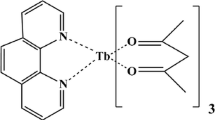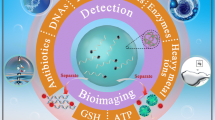Abstract
Zinc ion (Zn2+) is a necessary transition metal ion in the human body and plays a vital role in biological systems. Therefore, it is meaningful for rapid, sensitive, and specific detection of Zn2+. Herein, a “switch-on” fluorescence sensing platform for the detection of Zn2+ was successfully established. In this work, we report an optical nanoprobe with amino functional groups based on porphyrin metal-organic frameworks (PCN-NH2) through a simple treatment method. The modification of the salicylaldehyde (SA) through the C=N acts as a quencher of PCN-NH2 and the ligand of Zn2+ can effectively inhibit the fluorescence emission of PCN-NH2. The complex of porphyrin-based metal-organic framework and salicylaldehyde (PCN/SA) acts as the fluorescence sensing probe. The presence of Zn2+ results in the new emission peak at 448 nm due to the formation of a complex between Zn2+ and SA. The corresponding fluorescence signal changes were used to accurately detect the concentration of Zn2+. The fluorescence sensing platform shows advantages, including rapid response, high sensitivity, and excellent specificity with a linear detection range of Zn2+ between 0.1 and 250 μM, and a low detection limit (LOD) of 0.07 μM. And the feasibility of the method was verified for the quantification of Zn2+ in cell lysate, environmental water, and plasma.
Graphical abstract







Similar content being viewed by others
References
Wu D, Sedgwick AC, Gunnlaugsson T, Akkaya EU, Yoon J, James TD. Fluorescent chemosensors: the past, present and future. Chem. Soc. Rev. 2017;46:7105–23.
Xu ZC, Yoon J. Spring D R, Fluorescent chemosensors for Zn2+. Chem. Soc. Rev. 2010;39:1996–2006.
Tomat E, Lippard SJ. Imaging mobile zinc in biology. Curr. Opin. Chem. Biol. 2010;14:225–30.
Jordan MVC, Lo ST, Chen SW, Preihs C, Chirayil S, Zhang S, et al. Zinc-sensitive MRI contrast agent detects differential release of Zn (II) ions from the healthy vs. malignant mouse prostate. Proc. Natl. Acad. Sci. USA. 2016;113:E5464–71.
Zastrow ML, Huang Z, Lippard SJ. HaloTag-based hybrid targetable and ratiometric sensors for intracellular zinc. ACS Chem. Biol. 2020;15:396–406.
Kim JJ, Hong J, Yu S, You Y. Deep-red-fluorescent zinc probe with a membrane-targeting cholesterol unit. Inorg. Chem. 2020;59:11562–76.
Frederickson CJ, Koh JY, Bush AI. The neurobiology of zinc in health and disease. Nat. Rev. Neurosci. 2005;6:449–62.
Li Q, Zhao X, Lv Q, Liu G. The determination of zinc in water by flame atomic absorption spectrometry after its separation and preconcentration by malachite green loaded microcrystalline triphenylmethane. Sep. Purif. Technol. 2007;55:76–81.
Rao KS, Balaji T, Rao TP, Babu Y, Naidu GRK. Determination of iron, cobalt, nickel, manganese, zinc, copper, cadmium and lead in human hair by inductively coupled plasma-atomic emission spectrometry. Spectrochim. Acta B. 2002;57:1333–8.
Zhang C, Miura J, Nagaosa Y. Determination of cadmium, zinc, nickel and cobalt in tobacco by reversed-phase high-performance liquid chromatography with 2-(8- quinolylazo)-4,5-diphenylimidazole as a chelating reagent. Anal. Sci. 2005;21:1105–10.
Ji X, Ren J. Determination of copper and zinc in serum by derivative atomic absorption spectrometry using the microsampling technique. Analyst. 2002;127:416–9.
Xu YQ, Xiao LL, Sun SG, Pei ZC, Pei YX, Pang Y. Switchable and selective detection of Zn2+ or Cd2+ in living cells based on 3′-O-substituted arrangement of benzoxazole-derived fluorescent probes. Chem. Commun. 2014;50:7514–6.
Ponnuvel K, Kumar M, Padmini V. A new quinoline-based chemosensor for Zn2+ ions and their application in living cell imaging. Sensor. Actuat. B-Chem. 2016;227:242–7.
Zhang TT, Wang FW, Li MM, Liu JT, Miao JY, Zhao BX. A simple pyrazoline-based fluorescent probe for Zn2+ in aqueous solution and imaging in living neuron cells. Sensor. Actuat. B-Chem. 2013;186:755–60.
Bhasin AKK, Chauhan P, Chaudhary S. A novel coumarin-tagged ditopic scaffold as a selectively sensitive fluorogenic receptor of zinc (II) ion. Sensor. Actuat. B-Chem. 2021;330:129328–34.
Cao J, Zhao CC, Wang XZ, Zhang YF, Zhu WH. Target-triggered deprotonation of 6-hydroxyindole-based BODIPY: specially switch on NIR fluorescence upon selectively binding to Zn2+. Chem. Commun. 2012;48:9897–9.
Kreno LE, Leong K, Farha OK, Allendorf M, Van Duyne RP, Hupp JT. Metal–organic framework materials as chemical sensors. Chem. Rev. 2012;112:1105–25.
Chen B, Xiang S, Qian G. Metal−organic frameworks with functional pores for recognition of small molecules. Acc. Chem. Res. 2010;43:1115–24.
Liu D, Lu K, Poon C, Lin W. Metal–organic frameworks as sensory materials and imaging agents. Inorg. Chem. 2014;53:1916–24.
Chen YZ, Jiang HL. Porphyrinic metal–organic framework catalyzed heck-reaction: fluorescence “turn-on” sensing of Cu (II) ion. Chem. Mater. 2016;28:6698–704.
Pu G, Yang Z, Wu Y, Wang Z, Deng Y, Gao Y, et al. Investigation into the oxygen-involved electrochemiluminescence of porphyrins and its regulation by peripheral substituents/central metals. Anal. Chem. 2019;91:2319–28.
Ning X, Lu B, Zhang Z, Du P, Ren H, Shan D, et al. An efficient strategy for boosting photogenerated charge separation by using porphyrins as interfacial charge mediators. Angew. Chem., Int. Ed. 2019;58:16800–5.
Devaramani S, Shinger MI, Ma X, Yao M, Zhang S, Qin D, et al. Porphyrin aggregates decorated MWCNT film for solar light harvesting: influence of J- and H-aggregation on the charge recombination resistance, photocatalysis, and photoinduced charge transfer kinetics. Phys. Chem. Chem. Phys. 2017;19:18232–42.
Park J, Jiang Q, Feng D, Mao L, Zhou HC. Size controlled synthesis of porphyrinic metal-organic framework and functionalization for targeted photodynamic therapy. J. Am. Chem. Soc. 2016;138:3518–25.
Lu K, He C, Lin W. A chlorin-based nanoscale metal-organic framework for photodynamic therapy of colon cancers. J. Am. Chem. Soc. 2015;137:7600–3.
Du P, Niu Q, Chen J, Chen Y, Zhao J, Lu XQ. “Switch-on” fluorescence detection of glucose with high specificity and sensitivity based on silver nanoparticles supported on porphyrin metal-organic frameworks. Anal. Chem. 2020;92:7980–6.
Ma Y, Zhang YQ, Li XY, Yang P, Yue JY, Jiang Y, et al. Linker-eliminated nano metal-organic framework fluorescent probe for highly selective and sensitive phosphate ratiometric detection in water and body fluids. Anal. Chem. 2020;92:3722–7.
Li XQ, Zhou Z, Zhang CC, Zheng YH, Gao JW, Wang QN. Ratiometric fluorescence platform based on modified silicon quantum dots and its logic gate performance. Inorg. Chem. 2018;57:8866–73.
Chen MH, Zheng YH, Gao JW, Li C, Yu CF, Wang QM. Fluorometric determination of dopamine by using a terbium (III)inorganic-organic network. Microchim. Acta. 2017;184:2275–80.
Zhou Z, Wang QM, Lin JT, Chen YN, Yang CQ. Nucleophilic addition-triggered lanthanide luminescence allows detection of amines by Eu(thenoyltrifluoroacetone)3. Photochem. Photobiol. 2012;88:840–3.
Li ZY, Su HK, Zhou K, Yang BZ, Xiao TX, Sun XQ, et al. Oxo-spirocyclic structure bridged ditopic Schiff base: a turn-on fluorescent probe for selective recognition of Zn(II) and its application in biosensing. Dyes Pigm. 2018;149:921–6.
Song Q, Ma YS, Wang X, Tang T, Song YY, Ma YJ, et al. “On-off-on” fluorescent system for detection of Zn2+ in biological samples using quantum dots-carbon dots ratiometric nanosensor. J Colloid. Interf. Sci. 2018;516:522–8.
Dastidar DG, Mukherjee P, Ghosh D, Banerjee D. Carbon quantum dots prepared from onion extract as fluorescence turn-on probes for selective estimation of Zn2+ in blood plasma. Colloid. Surface A. 2021;611:125781–90.
Acknowledgements
Special thanks are due to the instrumental analysis at the Analytical and Testing Center, Northeastern University.
Funding
This work is financially supported by the National Natural Science Foundation of China (Nos. 21974018, 22074011, and 21727811), Fundamental Research Funds for the Central Universities (N2005015 and N2005027), and Liaoning Revitalization Talents Program (XLYC1907191, XLYC1802016).
Author information
Authors and Affiliations
Contributions
Xiao-Ping Zhang: literature research, scheme design, data collection and processing, and original draft writing. Bo Lin: literature research and data collection and processing. Yang Shu: scheme design, supervision, original draft writing, reviewing, and editing. Jian-Hua Wang: supervision, original draft writing, reviewing, and editing. All individuals who made contributions to this study are included as authors in this paper.
Corresponding authors
Ethics declarations
Human plasma samples of the three volunteers were collected at the Hospital of Northeastern University with the consent of the participants. All the experiments in this work were carried out in compliance with ethical standards and conducted according to the Declaration of Helsinki and approved by the Ethics Committee of Northeastern University (China).
Conflict of interest
The authors declare no competing interests.
Additional information
Publisher’s note
Springer Nature remains neutral with regard to jurisdictional claims in published maps and institutional affiliations.
Supplementary Information
ESM 1
(DOC 18120 kb)
Rights and permissions
About this article
Cite this article
Zhang, XP., Lin, B., Shu, Y. et al. “Switch-on” fluorescence sensing platform based on porphyrin metal-organic frameworks for rapid and specific detection of zinc ion. Anal Bioanal Chem 413, 5161–5168 (2021). https://doi.org/10.1007/s00216-021-03482-6
Received:
Revised:
Accepted:
Published:
Issue Date:
DOI: https://doi.org/10.1007/s00216-021-03482-6




